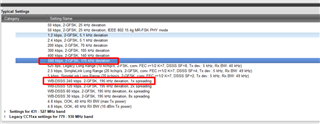Other Parts Discussed in Thread: CC1310, CC1350, CC1101
Tool/software:
Hi,
When I use SmartRF Studio7, I could only see the symbol rate is up to 480K Baud.
Does CC1310 support higher symbol rate of wide-band DSSS mode ? and how to implement ?
Thanks

This thread has been locked.
If you have a related question, please click the "Ask a related question" button in the top right corner. The newly created question will be automatically linked to this question.
Tool/software:
Hi,
When I use SmartRF Studio7, I could only see the symbol rate is up to 480K Baud.
Does CC1310 support higher symbol rate of wide-band DSSS mode ? and how to implement ?
Thanks

Hi Zack,
Thanks for the reply.
I'm trying to increase the symbol rate of WB-DSSS mode. do you know the highest symbol rate which can support for WB-DSSS ?
does the HSM support WB-DSSS ? I did not mean the options in SmartStudio.
Thank you again.
Yuning.
Hi Yuning,
500 kbps is the highest symbol rate that has been characterised as 480 kbps was the highest symbol rate it was developed for.
HSM does not support WB-DSSS, it is the least flexible PHY as it must use exact settings without any modification. GHS also does not support WB-DSSS.
You would need to either increase the RXBW setting and experiment yourself; it has not been tested with higher symbol rates and there are not plans to at this time (unless there is a large justification for it).
You can use the following App Note for general guidance: SWRA682 (Finding Settings for new PHYs for the CC13x0 and CC13x2 Family): https://www.ti.com/lit/swra682
One potential avenue that you could also explore is that the CC131x/CC135x devices (except for CC1310/CC1350) have a higher clock rate, so the potential for higher WB-DSSS symbol rate support is greater, but again untested.
Regards,
Zack
Hi Zack,
Thanks for the info.
It came out another question about WB-DSSS.
1. In Smart Stuidio, If we selected the spreading of WB-DSSS to 1, does it mean the difference between the one I selected and the original 2-GFSK is the FEC enabled or not ? (of course the symbol rate and the some other frequency related parameters are different ), but they are using the same channel coding method, is that correct ?

2. If I used the "500 Kbps, 2-GFSK, 175 Khz deviation ", how could I enable FEC ?
Thanks
Yuning
Hi Yuning,
You can find details of the WB-DSSS mode here: SWRA591 (Wide-Band DSSS Mode for FCC Digital Transmission Systems Using CC13x0): https://www.ti.com/lit/swra591
From SWRA591, you would be most interested in Section 2 and 3:

The SmartRF Studio settings are detailed in Table 3:

For regular 2-GFSK, the only FEC available is CC1101 compatible FEC, detailed here: https://dev.ti.com/tirex/explore/content/simplelink_cc13x0_sdk_4_20_02_07/docs/proprietary-rf/proprietary-rf-users-guide/proprietary-rf/cc1101-migration.html?highlight=forward%20error%20correction#forward-error-correction-fec
That might fulfil your requirements. The details of that implementation are found in SWRA113 (FEC Implementation): https://www.ti.com/lit/swra113
Otherwise, the other modes that have FEC enabled are WB-DSSS and LRM.
Regards,
Zack